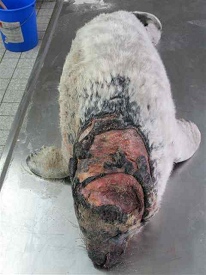
| Project data | |
|---|---|
| Project leader: | Prof. Prof. h. c. Dr. Ursula Siebert |
| Project term: | since April 2013 |
| Sponsorship: | Ministry of Energy, Agriculture, the Environment, Nature and Digitalisation (MELUND) |
Project description
Grey seals are the second domestic seal species in the waters of Schleswig-Holstein. For centuries, they were considered extinct in our waters. Grey seals have reappeared in the Wadden Sea and have been spotted in the last 25 years.
The project aims to investigate how these populations continue to develop and whether their growth influences the health status of the seals. Researchers perform thorough dissections and preserve tissue samples for histology, microbiology, virology, serology, parasitology and toxicology investigations. The size and weight of the animals are then measured. Biologic data such as age and reproductive status are recorded and material for feeding analysis is collected. The investigations are conducted in collaboration with other institutes of the University of Veterinary Medicine Hanover and the University of Giessen (Justus-Liebig-Universität). All sighting and marking data on gray seals collected by seal hunters are recorded in a central database.
Trends of habitat use will also be investigated and evaluated. Seal hunters will be trained to assist in collecting habitat use data for analysis. Because grey seals constitute migrating populations, data exchanges with neighboring countries are envisioned. The Common Wadden Sea Secretariat (CWSS) and the Trilateral Seal Expert Group (TSEG) are of particular significance



